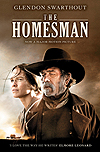
The Homesman, 122 minutes, Rated R, limited North American release in November 2014
Tommy Lee Jones said in a recent New York Times interview he wasn’t particularly interested in making Westerns. His latest film, The Homesman, has many elements of a Western––the frontier period, the unforgiving landscape, the horses, the cowboy––but like his directorial debut, The Three Burials of Melquiades Estrada, it’s far too eccentric in form to be pegged into a genre. Perhaps Jones’ filmmaking style is best described in the vaguest term: unconventional. You leave his second feature (he is also the producer) appreciating its distinctiveness, even if you remain unsure of its merit.
Based on the award-winning 1988 novel of the same name by Glendon Swarthout (author of The Shootist), The Homesman traces a journey across the cold and desolate Nebraska Territory in the 1850s. It’s a wilderness that diligent farmers like Mary Bee Cuddy (Hilary Swank) manage to call home. Mary Bee is well off but isolated, with no music in her life (she pretends to play piano on a tablecloth with painted-on keys) and no family. She invites a neighbor over for dinner and asks him to marry her, hoping to combine their land and livestock. He refuses, calling her “bossy.”
A disreputable hobo named George Briggs (Jones) also calls her “bossy,” and “plain as a tin can,” but after she rescues him from a lynching, he agrees to help her transport cargo across the territory—for $300 and a jug of whiskey. The “cargo” turns out to be three local women—Arabella Sours, Theoline Belknapp and Gro Svendsen—who’ve lost their minds, seemingly at the hands of their abusive husbands and grueling living conditions. The women are kept in a barred prison wagon for their eastbound trip to Iowa, and they scream endlessly, to the annoyance of Mary Bee, Briggs … and the audience. Actresses Grace Gummer, Miranda Otto and Sonja Richter have little more to play than simply “crazy,” and the film subjects us to an unnecessary barrage of gruesome images—multiple rapes, self-inflicted stabbings and, worst of all, a baby being tossed into a latrine. It seems like Jones kept adding these unpleasant scenes, unconvinced his film was bleak enough. It is.
That said, the film is often funny and unexpected. Jones enters the picture by tumbling his way out of an explosion in his long johns, like a relative of Elmer Fudd or Yosemite Sam. The old drunk with dry wit seems to be Jones’ calling card, and he is a perfect counterbalance to the rigid “good Christian” morality Swank brings to Mary Bee. Their interplay is the highlight of the film. However, when The Homesman is not being funny or unpredictable, it stalls.
The plot is episodic and meanders unsatisfactorily from one event on the trail to the next. The result is a film filled with familiar faces, like Meryl Streep, James Spader and Tim Blake Nelson, that aren’t given their full due. Sequences tease narrative directions and character relationships, then abruptly end. In the last act Jones has a great scene in which he butts heads with Spader’s uppity hotel manager. It has the feel of a foundation-laying scene––but then the conflict resolves (in the most old-fashioned of ways), and we move on down the trail. At its worst The Homesman’s wonky pace makes it feel like you’re watching a SparkNotes (for you old-timers, reading CliffsNotes) of the novel. Scenes and moments come to the brink of deeper meaning, of giving the audience some sort of emotional gratification or closer connection to the characters, and then fade out (literally “fade out”—there are lots of them) before we’re able to.
You’re left wondering, What is the point of it all? That the frontier just makes folks crazy? Perhaps, but while you’re wondering, a jovial Tommy Lee Jones dances and sings his way across a river on a ferry, having got all he wanted out of it—his whiskey and $300. What better way to end a film as eccentric as this than with a musical number? The Homesman is fresh and tedious. It’s funny and bleak. It follows the trail but has no direction. In other words, it’s unconventional.
Louis Lalire




